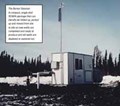Modular SCADA Package

Many of Alberta’s and British Columbia’s prime oil and gas properties are covered by muskeg, a spongy layer of matter that floats on the surface of the northern wetlands.
N/Aerta’s and British Columbia’s prime oil and gas properties are covered by muskeg, a spongy layer of matter that floats on the surface of the northern wetlands. The presence of muskeg, and its inability to support land vehicles, renders these remote areas virtually inaccessible during the summer months. Without remote monitoring and control systems in place, oil and gas producers are forced to either incur the high costs associated with leasing helicopter services and/or defer all site activity until after winter freeze up. Renaissance Energy is an aggressive oil and gas producer in western Canada and has taken a leading role in the development of gas field automation technology. In 1995, they approached the company to assist in the development of a cost-effective SCADA system that would not only provide accurate and real time remote monitoring and control functions, but also be physically flexible enough to be moved from site to site to accommodate shifting wellsite requirements.
Modular Skid
The separator skid consists of a Scanner 1140 RTU mounted inside the separator building in the Class 1 Div 1 hazardous area. The radio communications equipment is mounted on the outside of the separator building in the Class 1 Div 2 hazardous area. The solar panel and radio antenna are mounted to a sectional mast affixed to the base of the skid which can be simply lowered and removed when the skid is ready for transport.
Host System
This modularity and mobility presented some interesting wrinkles at the host side of the SCADA system. Human-Machine Interfaces (HMI) traditionally include an overview screen listing the wells being monitored.
This overview screen lists individual wells that can be selected to provide additional windows of information. In a field where new wells are added and old ones are removed on a monthly basis, companies face a constant barrage of expensive field service invoices to keep up with the ever changing list.
The company created a template that can accommodate up to a total of sixty wells per host. By accessing a password protected “Number of Wells” option, an operator can easily add or remove wells from the system.
Product Optimization
Two elements which proved to be especially effective were the systems’ blowdown control and plunger lift capabilities.
Blowdown control essentially evacuates any accumulated fluids from the production tubing by opening the well to the atmosphere for a brief period of time. The Renaissance system, designed to take full advantage of the Scanner 1140, allows the operator to set the control parameters and remotely schedule and initiate the blowdown procedure. The Scanner 1140 performs the timing function and actuates the valve; the valve position feedback comes from a limit switch and is input into the Scanner 1140. The information is then fed back to the host system and displayed on the HMI.
The plunger lift control is only slightly more complex but is generally considered safer, more environmentally friendly and less wasteful of natural gas. A plunger in the production tubing, carried by the pressure differential between the reservoir and the surface, lifts any fluids out of the wellbore. In this case, the operator initiates the process from the host, telling the Scanner to close the flow-line valve.
The plunger then falls to the bottom of the wellbore. The Scanner monitors the casing pressure and re-opens the flow-line valve after a preset period of time. At this point, the pressure differential carries the plunger back up the well, forcing out any liquids in front. These liquids are usually diverted out of the flow-line to a tank.
The Scanner can detect the plunger’s arrival at the surface through a limit switch input and can change the valve position to resume normal flow. Once again, valve position feedback is displayed at the host HMI.
System Benefits
The features of this modular SCADA system, such as the skid mounted field equipment, portable antenna mast and operator configurable host system, allows for the remote monitoring and control of virtually inaccessible wells at a surprisingly economical cost compared to conventional SCADA systems. At this same time, once the basic hardware and communications infrastructure are in place, the equipment can be used to increase production through a number of different production optimization techniques, such as blowdown control and plunger lift.
<%=company%>, 900 S. Turnbull Canyon Rd., City Of Industry, CA 91745. Tel: 626-961-2547 (Ext. 532). Fax: 626-961-4452.
